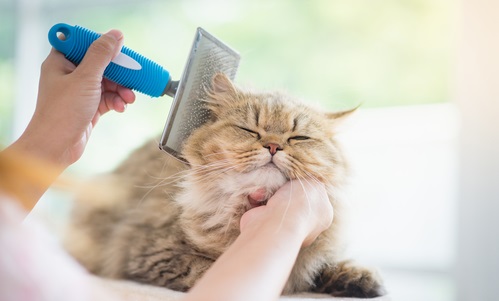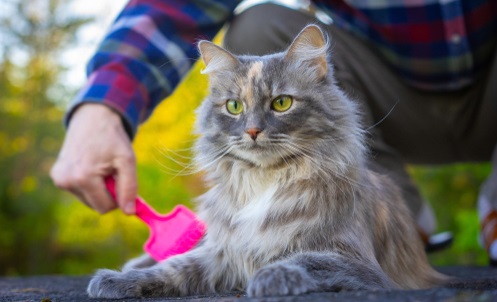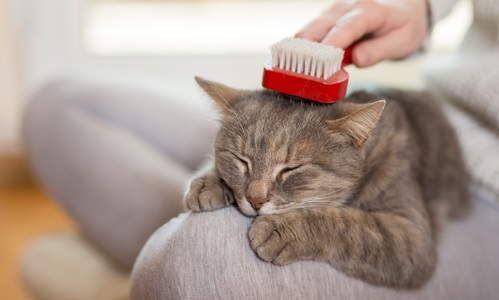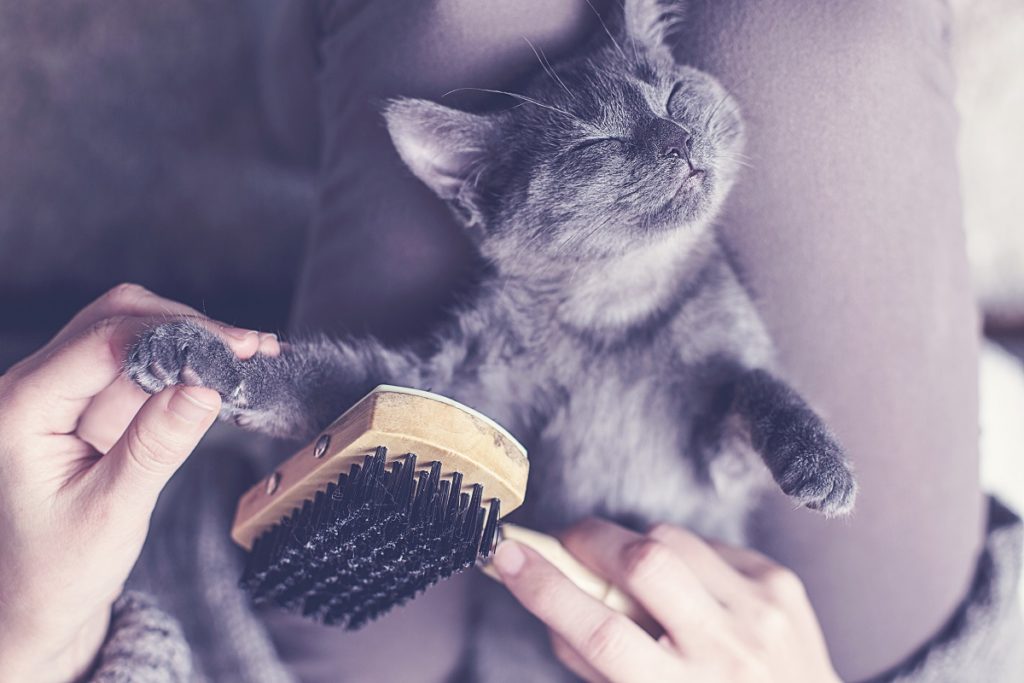Cats provide companionship, a swift and merciless end to any stray bugs in the house, and endless entertainment when the laser pointer comes out. However, there’s likely only one thing that a cat owner would change if they could: hairballs. Those messy puddles of fur, spit, and who-knows-what that have an uncanny ability to position themselves directly under your bare foot in the morning.
Sure, hairballs are a natural by-product of grooming – and cats can’t really help it – but for a pet parent that’s stepped in one too many, enough is enough! That irritation signals that it’s time to break out the tried-and-true solutions for cat hairball remedies, because a hairball-afflicted cat and his owner’s bedroom carpet both deserve better. Thankfully, preventing the majority of hairballs is a matter of a little brushing, potentially adding some natural supplements to his diet, and a bit of common sense. In the battle of owner-versus-hairballs, victory starts with knowing the opponent – every slimy, icky, inch of it. Hopefully by the end of this article, you’ll be able to have an effective cat hairball remedy that works for your furry companion.
Why Do Hairballs Happen?
Humans typically brush or comb their hair, or shave some part of their body, at least a few times a week. It’s a normal, healthy activity in any hygiene routine to keep a person looking and feeling their best. So what does that process look like for a fastidious cat?
- Imagine if humans had exponentially more hair to deal with: hair that was prone to static electricity, “bed head”, and all the other hairstyle woes, covering the entire body
- Consider how much more often people would need to engage in hygiene behaviors to stay looking sharp – no more keeping a convenient comb or brush in a purse or pocket
- Finally, imagine if such hairy humans didn’t have opposable thumbs to hold a brush or a razor, and instead had to essentially contort themselves to stay on top of looking good
While these are of course hypothetical scenarios, it may illustrate the difficulties cats are posed with – and better illuminate the reason a cat seems to be constantly grooming himself! Think about it: every square inch of his body is covered in fur, and it’s just as prone to dirt, oil, and snarls as a human’s hair is. This is even more true for indoor-outdoor cats that also have to contend with leaves, pollen, debris, curious trips in and out of the garbage, and nasty bugs such as ticks and fleas.
 Without a tool like a brush or electric razor, a cat needs to rely on a little evolutionary ingenuity: backward-facing barbs on his tongue called papillae. These barbs, the cause of that sandpaper-like sound whenever he licks something, are an efficient means at sweeping dead, shed fur off of his coat. The barbs face backwards, towards his throat, and unfortunately that means that a great deal of fur continues in that direction. Unable to dislodge the hair rasped off of his coat through licking, he will reflexively swallow it.
Without a tool like a brush or electric razor, a cat needs to rely on a little evolutionary ingenuity: backward-facing barbs on his tongue called papillae. These barbs, the cause of that sandpaper-like sound whenever he licks something, are an efficient means at sweeping dead, shed fur off of his coat. The barbs face backwards, towards his throat, and unfortunately that means that a great deal of fur continues in that direction. Unable to dislodge the hair rasped off of his coat through licking, he will reflexively swallow it.
A cat’s fur is also indigestible, which means that his stomach acid won’t be able to break it down. Much like the hair in a sink or bathtub drain, sometimes it slips through the pipes with no issues – and other times, it mats and tangles into a massive blockage. A plumber will get a drain-related human hair clog removed, but a cat relies on his hairball-ejection process to do the same for his digestive system. It’s inconvenient, gross, and alarming to his owners, but to a cat, it’s simply “business as usual”.
Managing Your Cat’s Hairballs: Helpful Tips
For pet owners fed up with hairballs and the discomfort of their feline friend, a plan of action is needed for taking on the root causes of these messy, unsightly events. Below, a step-by-step guide of tips and suggestions broken up into two helpful phases:
Step 1: “De-furring” Your Home
- Get that shed off the bed: Cats can get a little finicky when it comes to their human companions touching them, so the best hassle-free starting point is the fur that isn’t on their body. Most house cats shed a great deal, and their fur ends up on everything from rugs and furniture to their owner’s clothes. Removing fur from these surfaces keeps it from ending up tangled with a cat’s existing healthy fur and getting ingested during grooming. Use vacuum attachments, lint rollers, rubber or silicone fur brushes, and frequent laundry-washing to keep fur in its place: the trash.
- Get hands-on in the fur fight: If a cat allows his owner to pet him without hesitation, he’s a lucky kitty: that willingness makes it easy for a person to groom him. Use a rubberized mitt or brush designed for cat fur removal, proceed slowly, and watch his body language closely. A cat will quickly let a would-be groomer know if their preening skills are up to par (or in need of some serious practice). Mitt-style brushes serve double-duty here, too: if he gets annoyed enough to take a swipe at his owner during the brushing, there’s built-in hand protection to prevent scratches. An aggrieved owner can simply end the grooming session instead of reaching for the Band-Aids, and commit to trying again later.
- Consider enlisting professional help: Most pet parents have heard about dog grooming businesses and services, but are surprised to hear that cat grooming is also available. While it’s important to weigh a cat’s temperament and grooming needs carefully in the pros-vs-cons column, long-haired breeds like Maine Coon and Persian cats can benefit from a professional application of brushing and clipping. As a bonus, long fur around his tail can also be trimmed back at the same time in order to help combat bathroom hygiene issues.
- Mimic nature’s conveniences: In the wild, a cat’s feline ancestors had a host of surfaces to rub faces, sides, and bodies against. Tangles of vines and thorns removed stubborn mats of dead fur, and rough tree bark was excellent to rub cheek glands on. A similar fur-shedding experience can be provided at home by buying a few grooming-friendly toys, such as a bristle arch, or a wall corner accessory covered in grooming bristles for them to walk by. Cats, like their owners, appreciate a good, thorough back-scratch now and then, but the attraction factor can also be amped up with a pinch of catnip on the bristles as well.
- Keep the room temperature moderate: If he is an indoor-outdoor cat, he’ll start shedding more as the weather warms up in a natural response to his environment. If he’s indoor-only, however, his owner can game the system a little by keeping the temperature moderate. His genetics are tuned to shed hair when his body temperature is consistently higher, so a little air conditioning can make a dent, if not a massive reduction in lost fur.
Step 2: Fighting Hairballs Where they Start
- Clear the way in your cat’s digestive tract. Swallowed fur by itself is enough of an issue – it gets tangled and matted all on its own. Add digestive issues like inflamed bowels or an allergic reaction to ingredients in his food, and the issue compounds – literally. Now that hairball has even less room to keep moving through the digestive tract to a natural end in the litterbox. A vet can offer insight about the right food for a feline companion with these symptoms, and can also recommend “low antigen” (essentially, non-irritant) cat food varieties. In severe cases, a cat can develop feline hairball impaction, which will need to be treated by a veterinarian as soon as possible.
 Help keep things moving along. While humans tend to take fiber for entirely different gastrointestinal issues, the approach can also be beneficial for cats prone to hairballs. Adding, (with a vet’s approval, of course) a little unsweetened canned pumpkin puree or unflavored psyllium fiber to the feline diet can help his stomach more easily pass fur, preventing hairballs from forming in his gut. Care should be taken to monitor his reaction to the diet change, and his litterbox should be kept clean and ready for the – ahem – biological outcome.
Help keep things moving along. While humans tend to take fiber for entirely different gastrointestinal issues, the approach can also be beneficial for cats prone to hairballs. Adding, (with a vet’s approval, of course) a little unsweetened canned pumpkin puree or unflavored psyllium fiber to the feline diet can help his stomach more easily pass fur, preventing hairballs from forming in his gut. Care should be taken to monitor his reaction to the diet change, and his litterbox should be kept clean and ready for the – ahem – biological outcome.
- Use supplements for anti-hairball support. Over-the-counter pastes and gels are available, many in cat-appealing flavors, to help lubricate the stomach. Just as conditioner helps snarls and tangles fall out of human hair, these cat-safe, edible supplements give his stomach an extra layer of protection to prevent ingested fur from getting tangled against the stomach or intestinal walls. Much like supplementing his food with fiber additives, it’s important to make sure he has ready and constant access to his litterbox. This is particularly important the first few times this cat hairball treatment is administered to prevent accidents.
- Make sure hairball-prevention measures are house-wide: Some well-meaning cat owners bend over backwards to treat a feline struggling with hairballs, neglecting his household siblings in the process. Cats that have bonded will groom one another frequently to strengthen that bond, which means the fur bothering him might not all be his own. When taking measures with grooming and fur removal, make sure to include any and all other household pets in the process as well.
When to Worry About Hairballs
Despite the noise, mess, and inconvenience of hairballs, they’re generally harmless to cats –particularly if they’re small in size and infrequent. That doesn’t always mean they aren’t something to worry about, however – cats will often mask or hide symptoms of illness until their health situation is dire. Hairballs can actually be a telling sign of what’s really going on with his digestive system. As always, don’t take chances if he’s exhibiting signs of serious illness along with hairballs – e.g., disorientation, lack of appetite, head-pressing against the wall, and so on. If, however, his hairballs alone are the source of the problem, be on the lookout for these issues:
- Is the hairball particularly large? How a hairball looks can be an indication of any underlying health concerns. It may mean that he’s having trouble digesting or moving stools properly. Even a single large hairball is worth noting to a vet during a checkup – it may, in combination with other symptoms, help confirm a diagnosis for internal issues.
- Is your cat yowling or howling while vomiting the hairball? Cats are stealthy creatures, a trait that comes in handy while hunting prey and carries over even when they’re vomiting. While small vocalizations like “chittering” or meowing are common, loud, painful yowls are a big red flag that something is wrong. If he’s making these noises while vomiting or it looks like he’s struggling to excrete the hairball orally, get a vet involved. Excessive cat vomiting should also be a cause for concern, even if hairballs are not present.
- Is your cat coughing up hairballs constantly, particularly after eating? This may mean that there is so much fur in his stomach that he’s struggling to fit food in his gut as well. These particularly nasty hairballs may need medical assistance for removal, either naturally or surgically, if he’s struggling to keep food down as well.
- Does your cat’s hairball have excessive foam or foreign objects in it? Cats have a natural drive to hunt, and in the process of stalking and playing with “prey” in the home, they may accidentally swallow ribbon, debris, or small inedible objects that they later vomit up. A great deal of foam means he was physically churning and struggling to vomit, which could point to both foreign object ingestion or large, obscured hairballs in his digestive system.
 Is the cat’s hairball tinged with pink, or does it look like there is blood in it? Bear in mind that if his normal dry food has red, brown, or orange pieces, the discoloration may be coming from partially-digested kibble rather than a more worrisome cause. If, however, his hairball does look to be bloody or discolored, gather as much as possible in a plastic bag and make an emergency vet appointment to have him checked thoroughly.
Is the cat’s hairball tinged with pink, or does it look like there is blood in it? Bear in mind that if his normal dry food has red, brown, or orange pieces, the discoloration may be coming from partially-digested kibble rather than a more worrisome cause. If, however, his hairball does look to be bloody or discolored, gather as much as possible in a plastic bag and make an emergency vet appointment to have him checked thoroughly. - Is your cat exhibiting “the signs” (gagging, hacking noises, vomit posture) with no hairball? This is very common in cats that have an overly-large hairball blockage. Essentially, his body is fighting to expel the hairball orally, but the mass is too large to safely pass through the stomach or up the esophagus. The longer this problem is left unchecked, the more dangerous it can be for him. Additional food and fur add to the internal mass and make it even more uncomfortable – or potentially even fatal – over time, so it’s always better to be safe than sorry.
Summary: Staying Proactive To Minimize Feline Hairballs
Hairballs are a complex aspect of cat ownership. Knowing why they occur, what to do about them, and what to watch out for when a cat is vomiting will help calm any fears that deeper health concerns are hurting a feline companion. By maintaining a cat’s diet, grooming, cleanliness of the home, and overall health, pet parents can ensure the comfort of all parties involved.
Sources:
- Waggener, Dr. Natalie. “How to Prevent and Treat Hairballs for Your Cat.” South Boston Animal Hospital.com, March 27, 2018, https://www.southbostonanimalhospital.com/blog/how-to-prevent-and-treat-hairballs-for-your-cat. Accessed June 24, 2019.
- “9 Surprising Home Remedies for Cat Hairballs.” Canidae.com, April 26, 2017, https://www.canidae.com/blog/2017/04/9-surprising-home-remedies-for-cat-hairballs/. Accessed June 24, 2019.
- Rigley, Colin. “Tips for Brushing Your Cat and Why You Should.” Preventive Vet.com, December 6, 2017, https://www.preventivevet.com/cats/tips-for-brushing-your-cat-and-why-you-should. Accessed June 24, 2019.
- Smith, Melissa. “4 Mistakes You Might Make When Brushing Your Cat.” Petful.com, January 9, 2017, https://www.petful.com/grooming/mistakes-when-brushing-a-cat/. Accessed June 24, 2019.




